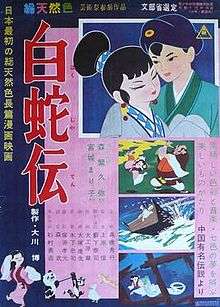Panda and the Magic Serpent
| Panda and the Magic Serpent | |
|---|---|
 Film poster | |
| Directed by |
Taiji Yabushita Kazuhiko Okabe |
| Produced by | Hiroshi Ôkawa |
| Written by |
Taiji Yabushita Shin Uehara |
| Starring |
Hisaya Morishige Mariko Miyagi Virginia Blackman Lisa Lu George Matsui Jodie McDowell Miiko Taka Mel Welles |
| Narrated by | Marvin Miller |
| Music by | Chuji Kinoshita |
| Cinematography | Takamitsu Tsukahara |
| Edited by | Shinataro Miyamoto |
| Distributed by | Toei Animation |
Release dates |
|
Running time | 78 minutes |
| Country | Japan |
| Language | Japanese |
Panda and the Magic Serpent (白蛇伝 Hakujaden), also known as The Tale of the White Serpent, is the first color anime feature film, released in 1958. It was one of the first three anime films to be released in America, under the title Panda and the Magic Serpent, premiering in 1961, the month after Magic Boy.[1] It is also known variously as Legend of the White Snake, The Great White Snake and The White Snake Enchantress.
Background

The film is essentially an adaptation of the Song Dynasty Chinese folktale "Legend of the White Snake" (白蛇傳).[2] Shin Uehara adapted the folktale and kept the Chinese-style characters and names. The decision of a Chinese story being used as the concept blueprint came from Toei president Hiroshi Ōkawa, who wanted to strike a tone of reconciliation with the Asian neighbors.[3]
Given the point in time, the film pushed Japanese animation technology to the limit. The film was a large scale major project, involving a total of 13,590 staff; surprisingly, it only took eight months to finish.[4] And while the film received honors at the Venice Children's Film Festival in Italy in 1959, it was regarded as a disappointment when released to the United States on March 15, 1961 by Global Pictures. Historically, this film marked Tōei Dōga's first attempt to follow the example of American feature animation studios and become the so-called "Disney of the east."
The US version made changes to the film such as interpreting the small red panda, Mimi, as a cat.[5] In addition, all traces of the Japanese production teams were removed from the credits.
Rintaro, who would later go on to become a well known and respected director of Japanese animation, had his first job in the animation industry (at age 17) as an in-between animator on this film.[6][7]
Plot
Xu-Xian, a young boy, once owned a pet snake in West Lake until his parents forced him to give her up. Years pass and during a violent storm, the snake magically transforms into the beautiful princess Bai-Niang. Bai-Niang finds Xu-Xian, but the lovers are separated by a local monk, Fa-Hai, who believes that Bai-Niang is an evil spirit. Xu-Xian's two panda pets, Panda and Mimi, try to find Xu-Xian. In the end, Bai-Niang gives up her magical powers and remains in human form to prove that her love for Xu-Xian is genuine.
Cast
| Character | Japanese voice actor | English voice actor |
|---|---|---|
| Xu Xian | Hisaya Morishige | George Matsui |
| Bai Niang | Mariko Miyagi | Lisa Lu |
| Xiaoqing | Mariko Miyagi | Miiko Taka |
| Panda | Hisaya Morishige | Fernando Tejada |
| Mimi | Mariko Miyagi | Virginia Blackman |
| Fahai | Hisaya Morishige | Mel Welles |
| Duck | Mariko Miyagi | Jodie McDowell |
| Weasel | Mariko Miyagi | Sara Meric |
| Dragon King | Hisaya Morishige | Bob Neuman |
| Catfish King | Hisaya Morishige | |
| Narrator | Hisaya Morishige | Marvin Miller |
See also
- History of anime
- The Legend of the White Serpent (1956 film) (Byaku fujin no yoren) directed by Shirō Toyoda.
References
- ↑ "Magic Boy (1959)". IMDbPro. Retrieved 13 January 2014.
- ↑ "Chinese Mythology." Bilingual Book Explanation of Legend of the White Snake. Retrieved on 2006-12-08.
- ↑ "Anipages Daily." Anipages Daily. Retrieved on 2006-12-08.
- ↑ "Masterpiece of last 50 years." Japanese Animated Film Festival. Retrieved on 2006-12-08.
- ↑ Clements, Jonathan. McCarthy Helen. [2006] (2006). The Anime Encyclopedia: Revised & Expanded Edition. Berkeley, CA: Stone Bridge Press. ISBN 978-1-933330-10-5
- ↑ Llewellyn, Richard (2007-05-12). "Rintaro Filmography". Animated Divots. Retrieved 2008-08-22.
- ↑ Berkwits, Jeff (2002-01-22). "Interview: Animation legend Rintaro reinvents the city to build a better Metropolis". Sci Fi.com Science Fiction Weekly. Archived from the original on 2008-05-05. Retrieved 2008-08-22.
Bibliography
- Panda and the Magic Serpent, DVD, Cartoon Craze.
External links
- Official website
- Panda and the Magic Serpent at the Internet Movie Database
- Panda and the Magic Serpent at AllMovie
- Panda and the Magic Serpent at Anime News Network's encyclopedia